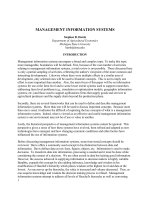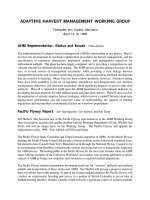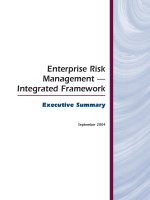Brand Management Waldemar Pfoertsch_9 doc
Bạn đang xem bản rút gọn của tài liệu. Xem và tải ngay bản đầy đủ của tài liệu tại đây (559.66 KB, 25 trang )
FedEx 213
Communicating the Brand
FedEx regards its own operations as one of the best channels of
communications they have. The close integration of their informa-
tion systems and transportation systems with those of their custom-
ers makes it even more difficult to switch to alternative market
offerings. One of the first things they see on the screen when they
turn on their PC is FedEx.
12
While most brands focus either on businesses or on consumers,
FedEx keeps them both on its radar screen. The primary target is the
B2B world, but in order to ensure that its ubiquitous brands main-
tain its leadership status they also build its master brand inside the
B2C universe.
All communications contribute to developing the FedEx brand im-
age and reputation. Advertising, direct mail, sponsorships, corpo-
rate identity sales force, couriers and information systems are used.
Maintaining its reputation and its brand image is a top priority
concern, since it is one of the most valuable things the company
has. As CEO, Frederick W. Smith regards guarding and champion-
ing the brand as an important part of his job.
13
Major branding deci-
sions are usually made by him, the Vice President of Marketing,
and the Director of Global Brand Management. Market research is
used to validate and provide guidance for execution.
14
Over the years, FedEx had several taglines: America, you’ve got a new
airline, Absolutely, Positively, Don’t worry. There’s a FedEx for that, Our
office is your office and Relax, it’s FedEx. The last one was so successful
that they launched a new advertising campaign in 2005, still using
this previous tagline. Communication elements comprise TV, print,
radio and online ads. The campaign is targeted at small businesses
and delivers the central message that the portfolio of FedEx services
will help them to meet their needs.
The launch campaign for the FedEx Kinko’s Office and Print Centers
in July 2004, incorporated TV spots, print, radio, direct mail and
online elements around the slogan Our office is your office. It was tar-
214 Success Stories of B2B Branding
geted especially at small businesses and had to reflect the one-stop
resources offered by the centers. FedEx has some kind of signature
style about its ads that is rooted in its rich heritage of humor in ad-
vertising.
15
The TV spots used a series of hilarious slices of small-
business life and were wonderfully wry and perfectly cast to deliver
a key point. News that is delivered in an entertaining fashion tends
to be more memorable for people. The humor in the advertising cam-
paign also has positive effects on FedEx’s sense of self-confidence.
The target audience of small business owners’ response to the spots
was overwhelmingly positive.
16
The average core customers of FedEx are primarily males between
the ages of 25 and 55. One central goal of communications is to place
the brand wherever this target group frequents. That’s the reason
why the company extended its sponsorship of the National Football
League for three years. It was also driving the decision to join forces
with Joe Gibbs Racing in 2005.
17
FedEx is sponsoring the #11 FedEx
Chevrolet during the 2005 NASCAR season. The FedEx Racing cam-
paign with the headline “Every Day Is Race Day” will be supported
by TV, print and online ads.
18
Sponsorships are used quite intensely at FedEx. Qualities like speed,
teamwork, and precision in building the largest express delivery
company in the world are held up high. These same qualities are
prominent in their sponsorships, resulting in rather natural and
complementary relationships.
19
The company regards this market-
ing tool a great opportunity to drive business and even integrates
the sponsorships as an anchor point throughout the marketing mix,
not the other way around. Certain events are used as content use-
able in media, promotions, employee incentives, and online. Exam-
ples include NFL-themed promotions, Orange Bowl-flavored retail
incentives, and PGA-related TV spots. The company uses sponsor-
ships to invade new markets and penetrate new areas, resulting in
high growth rates.
20
Sometimes companies get very lucky because their company
and/or brand are included in movies simply for plot reasons. FedEx
lucked out in 2003 when they benefited tremendously from product
Samsung 215
placement at no cost because the company and brand were featured
in the major motion picture Castaway starring Tom Hanks. Actually,
you could say that this was a two hour FedEx commercial that people
even paid to see. There were plenty of Fed Ex trucks, Fed Ex posters
and Fed Ex planes; you can imagine how much favorable exposure
FedEx received from this.
21
5.2 Samsung
Leveraging the Brand from B2C to B2B
Samsung is a Korean industrial group with a product portfolio rang-
ing from electronics, finance and construction to other services. It
successfully internationalized its business from local to global. Sam-
sung is headquartered in Seoul, South Korea. It is ranked as number
20 of the 100 most valuable brands worldwide carried out by Inter-
brand in 2005. This is an increase of more than 100% since 2000 with
brand value rising from US$5.2 billon up to US$12.5 billion. In
2005 the company had 175,000 employees and an annual turnover of
US$43.6 billon. Innovation and premium branding helped Samsung
to achieve profits of US$10.5 billion the same year.
Exporting dried fish and vegetables Samsung was founded in 1938
and started large scale manufacturing in the late 1950s in various
industries. In 1978, Samsung Semiconductor became a separate entity
producing for the domestic market. With the development of a 64K
DRAM (Dynamic Random Access Memory) VLSI chip (Very Large
Scale Integration electronics chips) it expanded globally. In the fi-
nancial crisis in 1997, Samsung was facing US$20 billion in debt and
had to slim down the company by more than 100 non-essential
businesses in a restructuring process. It kept only 47 affiliated com-
panies and strategically re-focused on four technical components:
displays, storage media, random access memory (RAM) and proc-
essors.
The restructuring process led Samsung also to focus on core busi-
nesses. It restructured its business into four strategic business areas
– Home Network, Mobile Network, Office Network and Core com-
216 Success Stories of B2B Branding
ponents – that support network products. Samsung implemented a
clear mission and vision across all core businesses:
Vision: “Leading the Digital Convergence Revolution”
Mission: “Digital e-Company”, i.e. a company that leads the
digital Convergence Revolution through innovative
Digital Products & e-Processes.
Also, Samsung focused on developing pioneering products and
technology in semiconductors, telecommunication devices and
home appliances field, which on the long-term made Samsung a
most competitive total solution provider in digital convergence.
The strategy to develop new markets and new approaches has led
Samsung to become a brand-led technology innovator. Its specialty
is to focus on its customer needs and to adapt quickly to changes in
consumer preferences.
Simultaneously to the reorganization of its business units, Samsung
established an intensive internal change management process –
where marketing activities were bundled under one Corporate Cen-
ter. The aim was to implement a holistic marketing strategy instead
of individual marketing plans to strengthen its market power and
to increase brand strength with high quality and innovative prod-
ucts. Samsung had to face the following challenges:
x Create one global brand and marketing strategy establishing a
clear brand vision and brand values to leverage brand’s suc-
cess across B2C and B2B businesses.
x Concentrate communication from customer to stakeholder
perspective as communication to non-customer stakeholder
groups becomes more and more important having a strong di-
rect brand impact.
x Increase communication planning from cost to investment
perspective along the entire brand screen.
x Expand position on chip/semiconductor market via cutting-
edge technology and concentrate communication to digital
consumers.
Samsung 217
Clear Brand Positioning
Samsung’s aim to build a clear brand positioning followed a struc-
tured approach. First, Samsung established a brand mission accord-
ing to the overall mission of the company. The mission reflected the
core values of the brand – being close to the customer, consider cus-
tomer needs and deliver innovative solutions.
Second, Samsung developed a distinctive value proposition to foster
its single brand strategy. The value proposition gave further detail
on the brand mission and explained how Samsung aimed to concen-
trate on a clear focus towards customer orientation and its promise
to innovate best-in-class technology. Moreover, the value proposi-
tion accentuated some emotional aspects the brand wanted to
communicate. The increased emotionality was then brought to life
in Samsung’s image campaign.
Looking back, in the 1990s, Samsung was the brand you bought if
you couldn’t afford Sony or Toshiba. But this image should change
a lot. The strategy was changed from a low cost and low quality im-
age to a price premium and market leader. Samsung aimed at pro-
viding leading-edge, stylish products.
Samsung established its brand as a brand known for the most fun
and stylish models ranging from cell phones to flat-panel plasma
TVs. Additionally, Samsung’s ability to produce almost any kind of
digital technology products, monitors, MP-3 players, TVs and
printers allowed the company to be mostly independent from main
component suppliers.
In a third step, Samsung deepened its single brand strategy via in-
troducing a new corporate identity program. It aimed to strengthen
competitiveness by bringing the attitudes and behavior of all em-
ployees in line with Samsung’s desired perception by the public.
Samsung’s corporate logo was redefined to reflect Samsung’s deter-
mination to become a world leader
22
.
The Samsung name was then written in English, expanding its global
presence throughout the world. The name was superimposed over a
218 Success Stories of B2B Branding
Fig. 56. The new Samsung logo
dynamic, new logo design, giving an overall image of dynamic en-
terprise. The elliptical logo shape symbolized the world moving
through space, conveying a distinctive image of innovation and
change. The first letter, “S”, and the last letter, “G,” partially break
out of the oval to connect the interior with the exterior, showing
Samsung’s desire to be one with the world and to serve society as a
whole.
The new logo was developed in the Corporate Marketing Center.
Brand campaigns were handled from the Headquarters, apart from
country specific adaptations and the media mix. Samsung began
making a strong push to build a reputation on digital convergence
from the late 1990s, using international competitions to gain fast
recognition. In 2001 Samsung won the first spot on the IDEA (Indus-
trial Design Excellence Award) list jointly with Apple Computer Co.
and was the sole winner in 2002
23
.
The new marketing strategy led to a US$400 million worldwide ad
campaign “digitAll-everyone’s invited”. The image campaign be-
came more emotional: For the first time Samsung’s new ad cam-
paign by Berlin Cameron/Red Cell told an emotional story, relating
Samsung’s products to every day situations. This was a change from
its rather product oriented communication strategy and a move to-
wards the image creation by its products. Samsung established a
controlling tool to measure the effectiveness and efficiency of its
communication activities and to identify improvement potentials
on each step of the customer relationship path. Since Samsung’s
concentration on a single brand strategy, the amount of global mar-
keting spending summed up to €2 billion (2004)
24
.
Samsung 219
Additionally, Samsung created an own universe for its campaign
situated in the Time Warner Center in New York and supported by
an online-world www.samsungexperience.com.
Excursions: The Samsung Experience is a remarkable 10,000-square-
foot interactive emporium of virtual reality experiences and tech-
nology. The permanent venue is located on the third floor of The
Shops at Columbus Circle in the Time Warner Center. Samsung has
created a range of experiences, each of which ties the Samsung
brand and technology to the experiences of everyday life. The site
features hundreds of Samsung products in unique technology dem-
onstrations such as a virtual world in a 360 degree interactive simu-
lation, a map of the city that can be manipulated with hand
gestures, and a digital fashion collection created by one of New
York’s hottest designers.
The Samsung Experience is not a store and is always free to visitors.
Visitors are invited to relax and learn how the latest devices can en-
rich their lives. Content from Samsung’s many partners, including
MIT Media Lab, Parsons School of Design, Napster, Microsoft, Time
Warner, Lincoln Center, and Sprint PCS, helps add to the experience.
“Samsung Experience is digital convergence in its purest form – where
you can see, hear, touch and create the art of the possible,” said
Dong Jin Oh, CEO of Samsung Electronics North America. “Our hope
is that the venue will become a great educational resource, commu-
nicating the life-enhancing benefits of digital technology without
the pressures of a sales environment.”
Samsung is also pioneering an innovative loaner program. Visitors
to the Samsung Experience will be able to take a hard-disk based
camcorder with them to shoot video around New York City. Once
they return, they can edit the footage at kiosks inside the Experi-
ence, burn their movies onto DVDs, and return home with a digital
souvenir. Visitors are also able to use Samsung Napster MP3 players
to download songs off Napster to CDs, and also download ring
tones to their cell phones. Images embedded in the venue’s giant
interactive map of the city can be transferred to customize post-
cards and create personalized artwork.
220 Success Stories of B2B Branding
Additionally, Samsung will host technology seminars and tutorials
at the Samsung Experience, as well as product launches and special
events. “Digital technology doesn’t need to be confusing and over-
whelming. The Samsung Experience will help people learn how to
take control of digital devices and use them to improve the quality
of their lives,” said Peter Weedfald, Samsung Electronics North
America senior vice president-marketing. “As a digital convergence
leader, Samsung is the perfect company to meet this need.”
“This is a major strategic play for Samsung,” said Stephen Baker,
NPD Techworld’s Director of Industry Analysis. “By creating a di-
rect consumer presence without relying on resellers, Samsung builds
not only brand awareness, but also greater appreciation for digital
technology overall. Everyone wins – especially consumers and re-
tailers, who benefit from better understanding of what digital living
is all about.” Early in the design and planning process, Samsung
recognized that its ultimate brand expression required many pio-
neers of the digital convergence revolution to achieve a total im-
mersion experience. Samsung enlisted a number of its long-time
partners and recruited new converts as well as to collaborate in
achieving the “art of the possible.”
“Our products, great as they may be, are just the enabler – ulti-
mately, this is not about products, but about the experience,” said
CEO Oh. “Working closely with content providers and other lead-
ing digital brands is the most gratifying part of what we’ve accom-
plished, and enables us to create the deepest, most satisfying
expression of the new digital lifestyle.”
25
Communication to All Stakeholders
For companies operating in the B2B sector a focus in communica-
tion on high impact groups is increasingly important to successfully
establish brand transfer. That is why, Samsung set up a comprehen-
sive program to ensure consistent communication to all stakeholders
considering the different roles of the brand. Samsung identified three
high impact groups:
Samsung 221
x Staff and customer base: brand’s role to build trust and foster
identification
x Target customers / financial community / broad public:
brand’s role to build trust platform, to trigger analyst expecta-
tions, to build goodwill platform (corporate citizenship)
x Talents / gatekeepers / opinion leaders: brand’s role to build
“preferred employer” position, build goodwill platform
Within this program, Samsung signed a deal in 2000 with Lucent
Technologies to supply internet phones and, in 2001, AOL Time War-
ner and Samsung agreed upon mutually promoting their brands
within a strategic marketing agreement.
Since 1998 Samsung has been an official sponsor of the Olympic
Games: Nagano (1998), Sydney (2000), Salt Lake City (2002) and
continues its sponsorship until 2008. During the Games Samsung
provides athletes, organizational staff and journalists with espe-
cially developed mobile phones promoting Samsung’s products and
delivering its promise of being an innovative and flexible company.
With the Olympic Games Samsung gained quick, cost-effective
global exposure. “I convinced the company we had to have a single
message,” says Kim. Its brand awareness increased after each
Olympics about 2% and had a huge impact on the quick rise of the
brand. Brand value increased since 2000 until 2004 about 100%.
For its target customers, Samsung established both in B2C and B2B
the concept of hero products. It means that each Samsung subsidi-
ary has to define at least one hero product, e.g. mobile phone, TV or
digital camera, which has – based on local or regional market re-
search – potential to become a blockbuster. Samsung very closely
involves its target customers in the development/research process
via generating feedback on its B2B online platforms.
Comprehensive Communication Planning
To achieve business impact, a common planning/monitoring across
disciplines is needed with a brand management via value creation
222 Success Stories of B2B Branding
and innovation rather than simple cost controlling. Samsung, when
switching its strategy towards a premium brand, started to move its
planning towards communication activities which have impact on
each step of the customer relationship path, i.e. from awareness to
purchase to loyalty.
Two major directions of impact towards high-end distribution
channels and an emotional approach for its campaign were Sam-
sung’s strategy. In its latest campaign, Samsung cemented the com-
pany’s new up market image by promoting its products in high-end
distribution channels.
Expand Position on New Chip / Semiconductor Market
Despite several challenging moments for the semiconductor indus-
try, such as the recession in early 1990s and early 2000, Samsung
aggressively increased its investments in the business unlike the
rest of the industry which laid-off workers to cut cost. This pre-
emptive investment strategy helped Samsung to gain market share
and to meet the rapidly growing demand for 4 megabyte chips after
1994 in the global market. Samsung became the number one mem-
ory chipmaker in 1993.
By pursuing twin goals of leading-edge technology and producing
one generation-old products in the niche market of memory chips,
Samsung successfully avoided risks of failing in the market. They
laid out Flash memory where text, photos, sound and screen can be
saved in the small-sized chips. Samsung’s market share of memory
chips has been growing continuously from 10.8% in 1993 to 28% in
2004, but it still follows Intel in the non-memory sector.
In 2000, Samsung asserted that digital consumers, a growing impor-
tance of business networks and technical devices would create new
demands for semiconductors in the future. Samsung recently an-
nounced its plans to beat Intel in computer chip sales and to make
a better partnership with it at the same time. Synergy effects will be
drawn when all three core elements of investment, leading-edge
Samsung 223
technology and the unique digital products work together within a
dynamic business interaction.
Samsung’s vice president Yun Jong-yong stated that the company
will try to become one of the top 3 electronics firms by 2010 in
terms of quality and quantity and will therefore try to raise its
brand value and revenues in its semiconductor business over Intel.
Despite tough competition Samsung and Intel both plan on building
better platforms to improve combined business opportunities.
Samsung is already leading the electronic market in some product
segments, such as in the set-top box as leading product in home net-
working. In late September, 2005, Samsung Electronics announced a
US$33 billion investment to add new production lines in Hwasung,
Gyunggi-do by 2012. It will be the largest semiconductor cluster
and create about 12,000 jobs. Samsung’s expects to achieve total sales
of US$61 billion when the project is completed.
Fig. 57. Interbrand brand equity development 2001-2005 (indexed; 2001 =
100)
26
224 Success Stories of B2B Branding
Besides being successful in this particular project Samsung increased
its overall brand equity tremendously. Compared with the peers
Dell, Panasonic, HP, Motorola and Nokia, Samsung doubled its Inter-
brand equity.
The conclusions we can draw are that Samsung successfully fol-
lowed a one brand strategy by establishing one global value
proposition, one logo and one consistent brand message Samsung
communicated the same values across all businesses to all stake-
holders, and followed a clear focus towards an emotional ap-
proach to increase brand image. Samsung followed also a pre-
emptive investment strategy to comply with digital consumers
demand and applied communication measures in an effective and
efficient manner, and they consistently communicated their
promise to offer innovative products perfectly tailored to cus-
tomer needs.
5.3 Cemex
Dual Branding to Create Brand Equity
Amazon.com founder, Jeff Bezos, has been quoted as saying he
would like to position his company to be able to sell anything –
except concrete.
27
Although the cement business is a commodity
industry characterized by low growth, high asset requirements
and unpredictable demand, Cemex defies one’s expectations re-
garding cement. Cemex (NYSE: CX), a cement company located in
northern Mexico, has undertaken a fast growing process in the last
decade to become the most profitable cement company in the
world. A clue for its success has been its accurate corporate brand
strategy. In 2003 & 2004, Cemex received the first place spot on the
Reader’s choice brand recognition of the brandchannel.com for
Latin America.
28
The Cemex brand success was only possible
through a strong brand strategy developed by the marketing
team at Cemex.
Cemex 225
Company History
Founded in 1906, Cemex started its dynamic growth in the 1990’s, and
in less than 10 years moved from No. 28 to No. 2 in the global cement
industry. Cemex reported that 2005 net income was more than quad-
ruple 2003’s net income. Cemex sold in 2005 more than US$15.3 bil-
lion (2004 US$8.2 billion) with a profit of US$3.6 billion (2004 US$1.3
billions), the most profitable company in its industry.
29
Cemex operates in more than 50 countries and has commercial re-
lations in over 90 nations. Cemex is engaged primarily in the pro-
duction, distribution and marketing of cement, ready-mix
products and aggregates. To provide these world-class products
and services to its customers, Cemex combines a deep knowledge
of local markets with its global network and information technol-
ogy systems. Known as a “digital leader”, Cemex has applied IT
and e-business ideology to this traditional low-tech industry, thus
transforming the rules of the game on most of the markets where
it is present. With the acquisition of RMC, Cemex is on the way to
the global leadership position.
30
However, being a technology leader is only part of the success of
Cemex. The Cemex Way is strongly focused in developing the right
behaviors and values of all Cemex people to integrate the world-
wide knowledge on products, customers and operations. This knowl-
edge is used to develop a robust process that shows the most
efficient practices, creating a business system easy to deploy in the
integration of new acquisitions around the world.
As described by the company, its business model is made of the
following elements: (1) focus on its core business of cement,
ready-mix concrete and aggregates (2) provide its customers with
the best value proposition (3) grow profitably through integrated
positions across its industry’s value chain (4) allocate capital ef-
fectively (5) and continuously improve their operating efficiency
and productivity.
31
226 Success Stories of B2B Branding
The Importance of Brand management for Cemex
Cemex CEO Lorenzo Zambrano had a distinctive vision of the indus-
try. For him the cement industry was really a culture industry, not a
cyclical commodity industry. This is the reason why brand position-
ing plays a significant role in the company’s market share. In many
of the company’s markets, cement is sold as a brand-name product
in bags. This is particularly true in fast growing developing econo-
mies, where cement is the most commonly used building material,
and brand positioning plays a major role in market share. The Ce-
mex brand holds a leading position in countries like Mexico, Spain,
United States, Venezuela, Dominican Republic, Costa Rica, Panama
and a significant presence in Colombia, Egypt, several Asian nations
and West & East European countries. These countries have major in-
frastructure needs and a relatively low per-capita cement consump-
tion, which translates into important growth potential.
Branded cement is one of the main building blocks of Cemex’s suc-
cess. And consumers associate Cemex brands with strength, durabil-
ity and tradition – the very essence of a good cement product. This
has enabled Cemex to differentiate its products and build customer
loyalty. In these volatile economies brand loyalty is a critical intan-
gible asset, so that the self-construction sector continues buying the
product through tough and prosperous times. Brand loyalty is per-
ceived by Cemex as a sustainable competitive advantage, and
therefore customer satisfaction is a top priority. Cemex believes that
a diligent brand management is required to serve customers distinct
preferences worldwide.
The Corporate Brand Strategy at Cemex
Cemex has developed a transnational brand strategy, with individ-
ual brands for each of the local products, but all of them under the
umbrella of the corporate brand. Historically, Cemex uses it grass-
roots products to create brand equity to its corporate brand, and
then uses their corporate brand to expand its value to new products.
This is achieved by a continuous endorsing of the product brands.
Cemex 227
First the promotion is focused on the local well-known product.
When the consumer is used to seeing the corporate brand, then
marketing is focused on building the corporate image.
Figure 58 shows two sponsored jerseys of the local soccer team of
Monterrey, Mexico. The first picture shows in the center the logo of
the Cemex cement brand sold in the area, and in small letters the
corporate Cemex logo. A jersey worn some seasons later shows the
corporate logo of Cemex in the center and the local Cemex cement
brand small.
Fig. 58. Cemex branding through sport promotion
Creating a strong corporate brand has been the most cost-efficient
advantage for Cemex.
32
The brand equity is easily carried into new
products and services. By continuously endorsing brands, both
segments – B2C and B2B – are maintained with a dual branding
concept. The individual brands in each country allow Cemex to
adapt to the specific functional needs of the consumer and price
constraints of the market. And the corporate brand vigor allows
Cemex to maintain a strong link to their B2B direct clients, the dis-
tributors and service users. Keeping a strong brand recognition
among its direct customers as well as the end consumer is crucial
for the company’s continuous growth.
Cemex is interested in maintaining a strong corporate brand and
few individual brands covered by the corporate brand. Due to its
228 Success Stories of B2B Branding
wide international expansion, each geographic business unit por-
trays the Cemex logo with the country name. Under each country,
it uses the Cemex logo to describe or endorse its main products or
services including all the Cemex cement brands and Cemex Ready
Mix (concretos). The corporate brand is also used to endorse other
B2B units such as Cemex Capital.
The Cemex brand is used to certify the quality of the product or ser-
vice. However, it is never used as a brand by itself on a product or
service. For example: Cement Cemex, or the usage of the logo ele-
ments on the product logo only. In that way the corporate brand is
protected from possible correlations or limitations to a specific area
of business.
In the 2004 annual report Cemex declared: “the Cemex trademark is
more than just a logo, slogan or mission statement; it is a promise we
make to our customers to deliver outstanding service and top quality
products”
33
. And today the Cemex brand is synonymous with
strength, prestige and stability in all the markets where present. A
company is not just evaluated by its financial results, but also by its
human resources competences, environmental sound policies, and
social responsible behaviors. And that has been achieved by Cemex,
creating a corporate brand not only appealing to the customer but to
all the stakeholders. Through a strong brand they had been able to
create a more appealing look to investors, attract better human talent,
increase the market value of the company, be a magnet for better
associates, and obviously increase sales on their products.
Their best way to create the strong brand image is through every-
day actions undertaken by the company. So that is why we can say
that each employee of Cemex has been responsible for the creation
of the current image. To do so, Cemex continuously communicates
through its internal IT channels any change in corporate direction;
and Cemex keeps a tight and limited usage of the logo, name and
business colors. This is particularly important, to keep the pace with
the aggressive business mergers and acquisitions, but still creating a
homogeneous internal and external business image.
Cemex 229
Corporate Brand
Country Units
Other B2B brands
Commercial Brand
Fig. 59. Cemex brand portfolio
34
As stated by Cemex, the values nurtured into its image are collabo-
ration, integrity and leadership. And some of the identified attrib-
utes in the corporate brand include: global company, customer
focus, investor focus, and technology innovation. The values and
attributes of the Cemex brand are easily recognizable throughout the
company activities and decisions.
Collaboration: Most of the business carried by Cemex is B2B
through selling to its distributors and not to the end customer. Ce-
mex showed its strong collaboration commitment by building and
licensing a brand to its major distributors. Construrama is now the
largest construction materials chain in Latin America. It is a win-
win proposition for Cemex’s customers and distributors. On one
hand, it offers distributors a number of advantages that they
couldn’t realize on their own such as brand recognition, access to
products and services at competitive prices, training programs, best
industry practices and marketing support from Cemex. And to the
end consumers, it offers guaranteed quality and uniformed service.
Cemex gains customer loyalty at both levels, and builds up an im-
age of collaborative enterprise.
230 Success Stories of B2B Branding
Integrity: Cemex’s commitment to integrity and social responsibility
is manifested through social programs such as “Patrimonio Hoy”.
35
This program is designed for low income families who do not have
the discipline to see a building project through. A family can con-
struct at approximately three times the traditional rate and at four-
fifths of the traditional cost. By 2003, Cemex had 26,000 families as
members, and over 100,000 had passed through Patrimonio Hoy. Ini-
tiatives like this strengthen the company image; but just as impor-
tantly, the payment rate was 99.6%.
Leadership: By applying technology to the issues that matter most
to customers, Cemex has strengthened their leadership brand image.
Named the Cemex Way, they have offered their clients improved
service, more efficient distribution, simplified business transaction,
and 24/7 access to real-time account information. The live elec-
tronic storefronts around the world enable clients to place orders
and purchase products online, as well as to track their account
states.
Global company: The challenge of managing a brand on all fronts
and across acquisitions is overwhelming, but Cemex has managed it
wisely. All its acquired subsidiaries have been renamed success-
fully. To protect the brand from a bad reputation, Cemex buys a
company, works to turn it around, and when it has a stable situa-
tion, renames it under the Cemex umbrella. Such is the case of Cemex
Thailand, bought in 2001 and renamed in 2002 after deep manage-
ment structure reorganization and a considerable improvement of its
processes, systems and product quality. In a similar way, Cemex
Spain was renamed in 2002 after a 3 year long process of image re-
furbish. The 3 Spanish business units: concrete, aggregates and
ready-mix concrete products were renamed also to Cemex Hormigon,
Cemex Morteros and Cemex Aridos.
Customer Focus: Cemex combines a deep knowledge on local mar-
kets with its global operational network. In this way, Cemex can offer
solutions tailored made to satisfy the particular needs of its clients.
Whenever possible, these solutions are marketed and sold under a
brand that endorses the Cemex logo, thus adding equity to the corpo-
Cemex 231
rate brand. For example, in 2003 Cemex Costa Rica discontinued its
30-year-old “Cempa” brand, and introduced the “Sanson” brand of-
fering two different types of cement, for structural construction and
for minor construction. This re-branding enhanced customer brand
recognition. Other examples include the Titan brand in Dominican
Republic for concrete block producers (2002), Vencemos in Venezuela
for do-it-yourself constructors (2003), and Al-Fanar Type II cement in
Egypt for coastal construction (2004), all under the Cemex umbrella.
Cemex’s brands are now positioned as the leading cement brand in
Upper and Lower Egypt, with 50% share of mind in their selected
markets. An additional example of customer focus and brand devel-
opment is the “Island” brand of Cemex Philippines who won in 2004
the Philippines National Shoppers Choice Award as the preferred brand
among more than 100,000 consumers surveyed countrywide.
36
Cemex Capital is a credit branch who gives financial support to the
business customers of Cemex subsidiaries. The support is not lim-
ited to the procurement of Cemex products, but also to finance
working capital, overall business growth of distributors, and loans
for construction companies. Created in 1997 under the Cemex corpo-
rate brand umbrella, Cemex capital offers credit at a lower cost than
the commercial banking.
Cemex’s CEO, Lorenzo Zambrano, believes that many other compa-
nies could use technology in a more effective way. So he launched
Fig. 60. Cemex: from stags to bags
232 Success Stories of B2B Branding
Neoris, a business consulting company that is based on Cemex’s
successful management capabilities. This subsidiary is part of the
B2B portfolio of Cemex, and although its brand has been set aside of
the influence of the central Cemex brand, it is solidly supported by
the corporate image. Neoris has sales above US$150 Million, with
one quarter of customers outside Cemex. Its main consulting ser-
vices include: IT consulting, outsourcing and management services,
and investment in emerging technologies.
Cemex has opened the eyes of many industries in Latin America and
throughout the emerging economies on the importance of an accu-
rate brand strategy and management as contributing to a corpora-
tion’s success. The Cemex corporate brand serves as an umbrella that
encapsulates the vision, values, personality, positioning and image of
the company. It has created a strong relationship with its key stake-
holders. And finally, it has been decisive for the proper development
of its B2B initiatives as a strong contributor to B2B success.
5.4 IBM
Successful Turnaround Through Brand Communications
When talking about the most valuable brands in the world IBM is
always included. According to the well-known Interbrand ranking,
the IBM brand is one of the top five of the world’s most valuable
brands, only surpassed by Coca Cola and Microsoft. Considering the
hard times the company had to go through only a few years ago,
literally walking on their last leg, this is an amazing success story.
The company has not only managed to prevent the demise of a once
great corporation and come back to business but it came back even
better and stronger, reviving the glow of the old times.
IBM is one of the companies with a very long and rich history. It
incorporated already in 1911 as the Computing-Tabulating-
Recording (C-T-R) Company and was formally renamed Interna-
tional Business Machines Corporation in 1924. Starting out as a
manufacturer of machinery ranging from commercial scales and
IBM 233
industrial time recorders to meat and cheese slicers along with
tabulators and punched cards, it has undergone massive transfor-
mations over the years.
37
We regard the refocusing of the global
IBM brand as an excellent example of how to manage B2B brands
and furthermore as one of the cornerstones of the successful turn-
around of the then struggling company. So let’s have a look at those
changes and how IBM managed to rebuild and strengthen the IBM
brand as we all know it today.
Crisis Time for the IBM Brand
IBM was performing very well in the 70s and early 1980s. They
were renowned for their own strong corporate culture and employee
selection procedures. High value had been placed on consensus-
based decision making, which, however, turned out to be a tremen-
dous weakness in the fast-moving mini computer industry of the late
1980s and 1990s. Slow and bureaucratic processes are not particularly
conducive to corporate risk taking which was necessary at that time,
and still is today. Back then the world made first steps towards a
commercial environment where rapid decision making and entre-
preneurial risk taking are indispensable. If the culture of a company
discourages and complicates such behavior, it easily and quickly can
drop out of the running. This happened to IBM when it found itself
outflanked by then-small companies like Atari, Apple, Commodore,
HP, Compaq Computers, Osborne, Tandy, or even Microsoft.
38
The following numbers clearly circumstantiate this: In 1981, IBM
introduced its first PC and managed to increase its market share to
41 percent by 1985 – only three years later the market share had
dropped to 28 percent. The blame for this loss was partly seen in
IBM’s unfocused marketing strategy that left their brand vulnerable
to cheap competitors’ clone products.
39
In 1993 finally, the struggling
company hit its negative peak by producing an US$8 billion loss,
which many marketer even regarded as the final nail in the slow-
moving mainframe behemoth’s coffin. The IBM brand and global
brand image was in deep trouble as well. The brand had not only lost
its strength from previous years, but almost became irrelevant. Crit-
ics began to see IBM as an elephant, and some as a dinosaur.
234 Success Stories of B2B Branding
Today, IBM is leading the pack again. It practically owns e-business
and solutions and dominates technology services, which now ac-
count for almost half of its revenues and more than half of its prof-
its. Most incredible is the fact that many customers, employees,
stakeholders, and Wall Street now describe IBM as nimble.
40
It is
not by chance that the very successful turnaround of the struggling
IBM has been attributed in part to the rigorous refocusing of their
well known global IBM brand and branding strategy.
Redefining IBM
In 1993, the former RJR Nabisco CEO and former president of
American Express, Louis V. Gerstner, Jr., took over IBM. Lou
Gerstner set out to transform IBM from a lumbering hardware
manufacturing company to a customer-focused service business.
This redefinition from a product oriented to a customer and market
oriented “builder of networks” also implied a renewed attention to
brand management and advertising.
41
One of Gerstner’s first decisions was to shift huge amounts of re-
sources to rebuild the IBM brand. The company chose to dial up
its master brand. This required serious adjustments for the product-
marketing teams. The umbrella quality reputation that the IBM
name provides for all of its products and services is far more valu-
able than specifications of individual products. An organization like
IBM can provide customers with numerous synergies and bene-
fits.
42
During the 1990s, IBM extended its brand portfolio relevance
to take advantage of a market opportunity in information technol-
ogy services and the Internet. Great market opportunities aligned
to IBM’s core competencies were further drivers of the subsequent
brand repositioning.
43
As part of the strategy to reinvigorate the IBM brand the company
fired its 70 global agency partners and consolidated all its global
advertising business with Ogilvy & Mather (O&M) in 1994. This
consolidation resulted in integrated and more effective marketing
communications and uniform branding at a much lower total
IBM 235
communications cost. Since then the company strongly invested in
marketing and brand building which enabled them to make over
the IBM brand image.
44
The new IBM was positioned as a com-
pany that understands the needs of its business customers and
that can provide a total portfolio of products, services and consult-
ing advice. The 360-degree marketing communications strategy
developed by O&M included TV, print, outdoor, events, sports
sponsorships, online and non-traditional media to communicate
its brand positioning.
45
The company understood that in order to achieve real change they
had to reach not only their customers but also and maybe even
more importantly, their employees. Therefore the company devel-
oped advertising aimed at changing the perceptions of both sets of
constituents. To educate and empower their employees was one of
the major steps towards the new IBM.
46
Part of IBM’s massive reorganization strategy has been to put
235,000 employees into 14 customer-focused groups such as oil and
gas, entertainment, and financial services. This way a big customer
will be able to cut one deal with a central sales office to have IBM
computers installed worldwide. Under the old system, a corporate
customer with operations in 20 countries had to contract with 20
little Big Blues, each with its own pricing structure and service
standards.
47
At IBM, new reps receive extensive initial training and
may spend 15 percent of their time each year in additional training.
IBM has now switched 25 percent of the training from classroom to
e-learning, saving a great deal of money in the process.
48
Frontline
employees can spend up to US$5,000 to solve a customer problem
on the spot.
49
The global brand manager (GBM) was an individual charged with
creating a global brand strategy that leads to strong brands and
global synergy. At IBM, the slot was called Brand Steward
50
, re-
flecting the role and position of building and protecting brand
equity.
236 Success Stories of B2B Branding
“One of IBM’s key media strategies is to deploy traditional
media in radically new ways. For example, IBM is using
video online to communicate its brand message to an audience
of IT and business decision-makers. It has partnerships with
ESPN.com, CNN.com and other Web sites to deploy interac-
tive video interviews with key IBM executives and other con-
tent to connect with its target audience.Whenweare
trying to reach loyalists for a given server platform, it wouldn’t
be economical to deliver the message using traditional TV. IBM
also uses sports sponsorships and huge events to build its
brand. As the technology provider for the U.S. Open tennis
tournament this year, IBM delivered real-time scoring on a
large interactive billboard in Times Square, as well as on
traveling vans in New York. It is a real live demonstration of
our business consulting and technology expertise”.
51
During the middle to late 1990’s, when many firms were attempt-
ing to be relevant to the Internet and the emerging network world
of business, IBM was a trend driver with its e-business position. The
company ultimately spent over US$5 billion building the eBusiness
“label” after its introduction in 1996, and related all its business
units to that context.
52
Sam Palmisano, who became the new CEO of IBM in 2003, had a
difficult act to follow. IBM had achieved a dramatic turnaround
under Lou Gerstner during the 1990s, in part by making the syn-
ergy and technology of the organization work for the customer.
Palmisano’s strategy was based on a new value proposition: On
Demand. The core idea was that IT systems and resources would
be available on-demand, when needed. All IBM business units
were charged with delivering the value proposition.
53
In 2003,
IBM created in addition another subcategory, eBusiness on De-
mand, which means that firms would develop an IT system that
would encompass suppliers, customers, and partners and deliver
information and computer resources on demand, when needed.
The creation of responsive products and services throughout the
firm to meet this set of customer needs was unreachable by com-
petitors.
54
IBM 237
This other big shift was the enlargement of the service offerings.
Currently, almost half of IBM’s annual revenues come from global
services. To fulfill its service promise, IBM has had to develop new
skills and become more customer focused. The US$3.5 billion acqui-
sition of PriceWaterhouseCoopers Consulting in October 2002 has
further provided valuable strategic and operational expertise.
55
Today IBM has left the field of personal computer production. The
last part of the huge industrial project of the last decade has been
sold to one of their joint venture partner in China. Lenovo paid
US$1.25 billion for the other part of the JV and the distribution sys-
tem and the distribution rights of the IBM brand for the next 5
years. The exit of the foremost leading PC manufacture shows that
IBM has learned from its mistakes.
IBM Campaigns
The IBM brand essence, “magic you can trust” captures the inspira-
tional aspect of their products and services, combined with the
trust generated by the company’s heritage, size, and competence.
Because of its varied markets however, IBM uses several taglines:
“Solutions for a small planet” is relevant for a customer seeking so-
lutions and inspiring to those with a global vision, while “e-
business” positions IBM as the dominant choice for those seeking
help with e-commerce. IBM used the e-business subbrand to make
an association it owned, technological leadership, more dynamic,
relevant and contemporary.
56
In 2001 IBM and Ogilvy & Mather were awarded a gold trophy in
the Computer Software category for the Software Evangelist cam-
paign. The campaign, designed to promote IBM’s e-business soft-
ware, included television and print ads. It also marked the first time
IBM touted itself as a software provider. The campaign tag line was
“It’s a different kind of world. You need a different kind of soft-
ware.” The campaign helped IBM become the number one provider
of “middleware” – a “fundamental building block for e-business”—
and contributed to the company’s US$13 billion in software revenue
during 2000.
57









